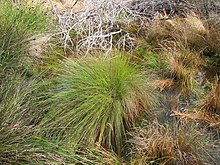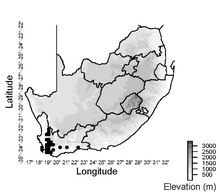Schoenus gracillimus is a species of sedge endemic to the Western Cape Province of South Africa.[1]
| Schoenus gracillimus | |
|---|---|

| |
| Slender veldrush | |
| Scientific classification | |
| Kingdom: | Plantae |
| Clade: | Tracheophytes |
| Clade: | Angiosperms |
| Clade: | Monocots |
| Clade: | Commelinids |
| Order: | Poales |
| Family: | Cyperaceae |
| Genus: | Schoenus |
| Species: | S. gracillimus
|
| Binomial name | |
| Schoenus gracillimus T.L.Elliott & Muasya
| |

| |
| Documented collection localities in South Africa | |
| Synonyms[1] | |
| |
Description
editThe inflorescence of S. gracillimus has few spikelets (usually less than five), which is similar to Schoenus adnatus, Schoenus crinitus and Schoenus schonlandii.[1] However, the spikelets of S. gracillimus are often pendulous (hanging) on long pedicels, whereas the other three species do not share this character.[1]
Compared to both S. adnatus and S. gracillimus, S. crinitus is a more hairy and rigid species.[1] In addition, S. gracillimus does not have spikelet receptacles that are adnate to the basal glume (bract), as in S. adnatus.[1]
Although there are slight differences in plant and spikelet form, the distributions of S. gracillimus and S. schonlandii differ (S. gracillimus generally grows more to the west).[1]
Difficulties in identifying the southern African Schoenus might be partially explained by their tendency to form hybrids with each other.[1][2] Preliminary evidence suggests that S. gracillimus might form hybrids with other southern African Schoenus species.[1]
-
Flowering head (inflorescence)
-
Spikelet
-
Nutlet (the black scale bar represents 1 mm)
Taxonomy
editSchoenus gracillimus is a species in family Cyperaceae, tribe Schoeneae.[3][4][5] This tribe includes other notable genera such as Costularia, Gahnia, Lepidosperma, Oreobolus and Tetraria. Phylogenetic and morphological evidence suggests that species in the Epischoenus group are the closest relatives to S. gracillimus.[1][4]
The genus Tetraria once included species from the southern African Schoenus; however, we now know that the two groups are evolutionary distinct based on morphological and molecular differences.[6] Several species of Epischoenus and the southern African Tetraria were transferred into Schoenus to ensure that the genus is monophyletic (i.e. the genus only has closely related species).[6] In the field, the main distinguishing characters between Tetraria and Schoenus are the lack of stem leaves and absence of reticulate sheaths at the bases of the flowering stems in the latter genus.[6]
Distribution and habitat
editMost collections of Schoenus gracillimus have been from damp sites in the mountains of Western Cape Province.[1] However, some collections have been made from elevations near sea level.[1]
Gallery
edit-
Growth form
-
Growth form
-
Flowering head
-
Flowering head
References
edit- ^ a b c d e f g h i j k l Elliott, T.L.; Muasya, A.M. (2020). "A taxonomic revision of the Epischoenus group of Schoenus (Cyperaceae, tribe Schoeneae)". South African Journal of Botany. 135: 296–316. doi:10.1016/j.sajb.2020.08.029.
- ^ Levyns, M. (1947). "Tetraria and related genera, with special reference to the flora of the Cape Peninsula". Journal of South African Botany. 13: 73–93.
- ^ Elliott, T.L.; Barrett, R.L.; Muasya, A.M. (2019). "A taxonomic revision of Schoenus cuspidatus and allies (Cyperaceae, tribe Schoeneae)—Part 1". South African Journal of Botany. 121: 519–535. doi:10.1016/j.sajb.2018.11.021.
- ^ a b Viljoen, J.-A.; Muasya, A.M.; Barrett, R.L.; Bruhl, J.J.; Gibbs, A.K.; Slingsby, J.A.; Wilson, K. L.; Verboom, G.A. (2013). "Radiation and repeated transoceanic dispersal of Schoeneae (Cyperaceae) through the southern hemisphere". American Journal of Botany. 100 (12): 2494–2508. doi:10.3732/ajb.1300105.
- ^ Larridon, I.; Bauters, K.; Semmouri, I.; Viljoen, J.-A.; Prychid, C.J.; Muasya, A.M.; Bruhl, J.J.; Wilson, K.L.; Senterre, B.; Goetghebeur, P. (2018). "Molecular phylogenetics of the genus Costularia (Schoeneae, Cyperaceae) reveals multiple distinct evolutionary lineages". Molecular Phylogenetics and Evolution. 126: 196–209. doi:10.1016/j.ympev.2018.04.016.
- ^ a b c Elliott, T.L.; Muasya, A.M. (2017). "Taxonomic realignment in the southern African Tetraria (Cyperaceae, tribe Schoeneae; Schoenus clade)". South African Journal of Botany. 112: 354–360. doi:10.1016/j.sajb.2017.06.011.